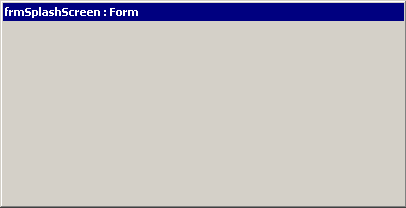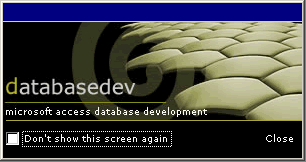databasedev.co.uk - database solutions and downloads for microsoft access
Microsoft Access Articles
- General Microsoft Access Articles
- Microsoft Access 2007 Articles
- Tables
- Queries
- SQL
- Forms
- Reports
- Macros
- Modules & VBA
- Data Models
- Downloads
GUI Design
Resources
Online Shop
Info
Microsoft Access Splash Screen Tutorial
Creating a Microsoft Access Splash Screen:
Software applications often display a splash screen when launching. With Microsoft Access you will often see the splash screen displayed before being presented with the database switchboard or similar form.
The splash screen in Microsoft Access will usually display a logo of the company that has created the database application, contact details of the person responsible for the administration and maintenance of the database or will sometimes display other useful information or tips associated with the database.
We can use the screen to display randomly selected tips or help topics, providing the tip will benefit the end user. To avoid irritating the user, we should also provide them with the option of not having the splash screen appear in the future.
This tutorial details:
How to create and add a splash screen to your Access Database
- In the database window choose Forms from the Objects. Double-click Create form in Design View
- Open the Properties dialog box for the form (View » Properties)
and on the Format tab set the following properties:
Property Value Scroll Bars Neither Record Selectors No Navigation Buttons No Dividing Lines No Auto Center Yes Border Style Dialog Control Box No Min Max Buttons None Close Button No - Choose File » Save and save the form as frmSplashScreen
The form should look similar to below. We will now want to start modifying this and making it look more presentable:

- Change back to form design view. Now, from the Toolbox (if this
is not visible go to Tools » Toolbox) and click on the Image
tool. With the image tool selected click in the form detail section.
The Insert Picture dialog box appears. Select the image that you want to include in the form and click OK. Access inserts your image in the image control on the form. Select the image and position in the correct location.
As our chosen image is a particular colour, we also need to modify the background colour of the form details section to match. If we right-click on an empty section of the form background, and from the pop-up menu chose Fill/Back Color and select a matching colour (in our case black). - Next we want to add a Check Box control. Add the checkbox to the
bottom left hand side of your form.
For the properties of the check box, set the name of the control to chkShowHide, then from the data tab set a default value of 0 for the control.
Set the label caption for the check box to "Don't show this screen again" - Add a label control to the bottom right hand corner of the form. Set the name for the control to lblClose and set the caption for the label to "Close". We will use this to close the splash screen form by adding code to the click event of the label.
- If we view the form in form view it will now look similar to the
following example:

- Now, we need to add code to the On Click event of the Close label
that will act as a command to close the splash screen form. In design
view of the form, select the label (lblClose) and from the properties
sheet choose the Event tab, then select the On Click event.
Using the drop down arrow in the On Click property, select [Event Procedure] and then click on the Ellipsis button (...) to open up the Visual Basic Editor. Enter the following code:
Private Sub lblClose_Click() On Error GoTo Err_lblClose_Click ' Close the splash screen & ' Open the main database form, frmMain DoCmd.Close DoCmd.OpenForm "frmMain" Exit_lblClose_Click: Exit Sub Err_lblClose_Click: MsgBox Err.Description Resume Exit_lblClose_Click End Sub - We also need to add some code to the Form Open and Form Close
events, that will perform actions depending on the selection made
in the checkbox contained on the form (the checkbox that gives the
user the option of not displaying the splash screen in future when
they open the database). The events will set options as to which
form is displayed at start-up, dependant on user preference.
Add the following two sets of code to the Open and Close event procedures for the form:
Private Sub Form_Open(Cancel As Integer) On Error GoTo FormOpen_Err If (CurrentDb().Properties("StartupForm") = "frmSplashScreen" Or _ CurrentDb().Properties("StartupForm") = "Form.frmSplashScreen") _ Then Forms!frmSplashScreen!chkHideSplash = False Else Forms!frmSplashScreen!chkShowHide = True End If FormOpen_Exit: Exit Sub FormOpen_Err: If Err = 3270 Then Forms!frmSplashScreen!chkShowHide = True Resume FormOpen_Exit End If End Sub '---------------------------------------------------------------- Private Sub Form_Close() On Error GoTo Form_Close_Err If Forms!frmSplashScreen!chkShowHide Then CurrentDb().Properties("StartupForm") = "frmMain" Else CurrentDb().Properties("StartupForm") = "frmSplashScreen" End If Exit Sub Form_Close_Err: If Err = 3270 Then Dim db As DAO.Database Dim prop As DAO.Property Set db = CurrentDb() Set prop = db.CreateProperty("StartupForm", dbText, _ "frmSplashScreen") db.Properties.Append prop Resume Next End If End Sub - Save the design of the splash screen, then go to the Tools menu,
where we need to set the start-up options.
From the menu, choose Startup to display the startup options dialog box.
Select frmSplashScreen in the Display Form/Page drop down list.
This form will now be displayed the first time that the database is opened.
To see this example in action, you can download the sample Microsoft Access database from the Microsoft Access Forms page or the Microsoft Access Downloads page.